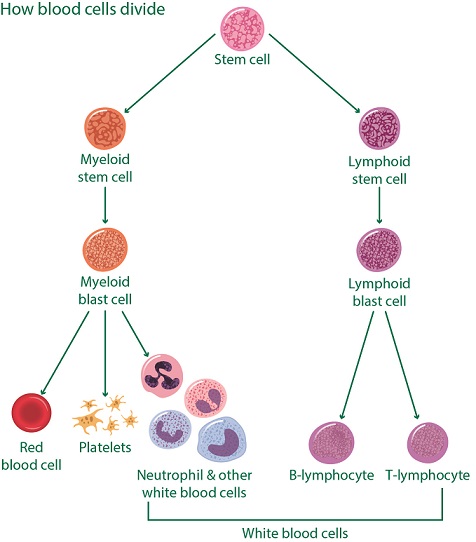September is Blood Cancer Awareness month. In this blog you can find out about the 3 main types of blood cancer (leukaemia, lymphoma and myeloma) and the symptoms to be aware of.
To understand blood cancers, it helps to know a little about how the blood and blood cells work. Blood is made up of different types of blood cells:

Blood cells are made in the bone marrow. This is the spongy material found inside our bones. The bone marrow usually makes billions of new blood cells every day to replace old and worn-out ones. Blood cancer happens when something goes wrong, and the blood cells do not develop properly.
There are different types of blood cancer. They can affect your blood, bone marrow or lymphatic system. The lymphatic system helps to protect us from infection and disease and drains fluid from the body’s tissues.
Find out about the different ways you can help Macmillan to raise awareness and funds to support people living with blood cancer.
Leukaemia is a cancer of the white blood cells. Leukaemia can be fast growing, known as acute leukaemia. When it is acute, the symptoms may appear very quickly over a few weeks and people may feel ill quite quickly. The most common types are acute lymphocytic leukaemia (ALL) and acute myeloid leukaemia (AML). Most symptoms of acute leukaemia are caused by leukaemia cells filling the bone marrow. This means healthy blood cells do not move into the blood as normal.
Or leukaemia can be slower growing. This is known as chronic leukaemia. In early stages of chronic leukaemia, many people don’t have symptoms or symptoms develop more slowly, over months or years. The types of chronic leukaemia are chronic lymphocytic leukaemia (CLL) and chronic myeloid leukaemia (CML).
Lymphoma is a cancer of the lymphatic system. In lymphoma, blood cells called lymphocytes have become abnormal.
There are 2 main types of lymphoma – Hodgkin lymphoma and non-Hodgkin lymphoma (NHL).There are many types of NHL. Some grow very slowly and may not need treatment for months or years and may not need treatment at all.
The most common symptom of lymphoma is a painless swelling or lump in one or more the lymph nodes. For example, this may be in the neck, armpit or groin. This is caused by lymphoma cells building up in the lymph nodes. Some of the symptoms may also depend on where the lymphoma is in the body.
Some symptoms of lymphoma can be the similar to leukaemia. For example:
Myeloma is a cancer of the plasma cells, in the bone marrow. Plasma cells are a type of white blood cell which fight infection. In myeloma, the process of developing plasma cells is out of control and lots of abnormal plasma cells (myeloma cells) are made.
The myeloma cells fill up the bone marrow and make it hard to make healthy blood cells. The bone can also become damaged.
Symptoms of myeloma may vary and it might not cause any symptoms in the early stages.
Symptoms can include:
All the symptoms we mention here are common to many illnesses other than blood cancer. But if you have any of the symptoms, you should have them checked by your GP.
Whatever cancer throws your way, we’re right there with you.
We’re here to provide physical, financial and emotional support.
© Macmillan Cancer Support 2026 © Macmillan Cancer Support, registered charity in England and Wales (261017), Scotland (SC039907) and the Isle of Man (604). Also operating in Northern Ireland. A company limited by guarantee, registered in England and Wales company number 2400969. Isle of Man company number 4694F. Registered office: 3rd Floor, Bronze Building, The Forge, 105 Sumner Street, London, SE1 9HZ. VAT no: 668265007